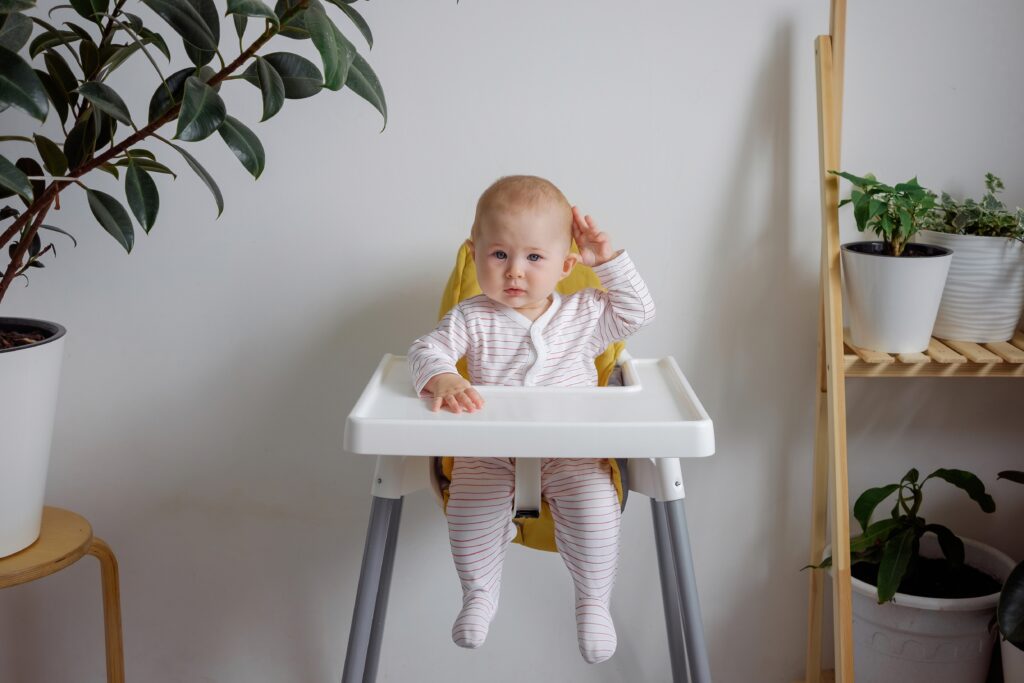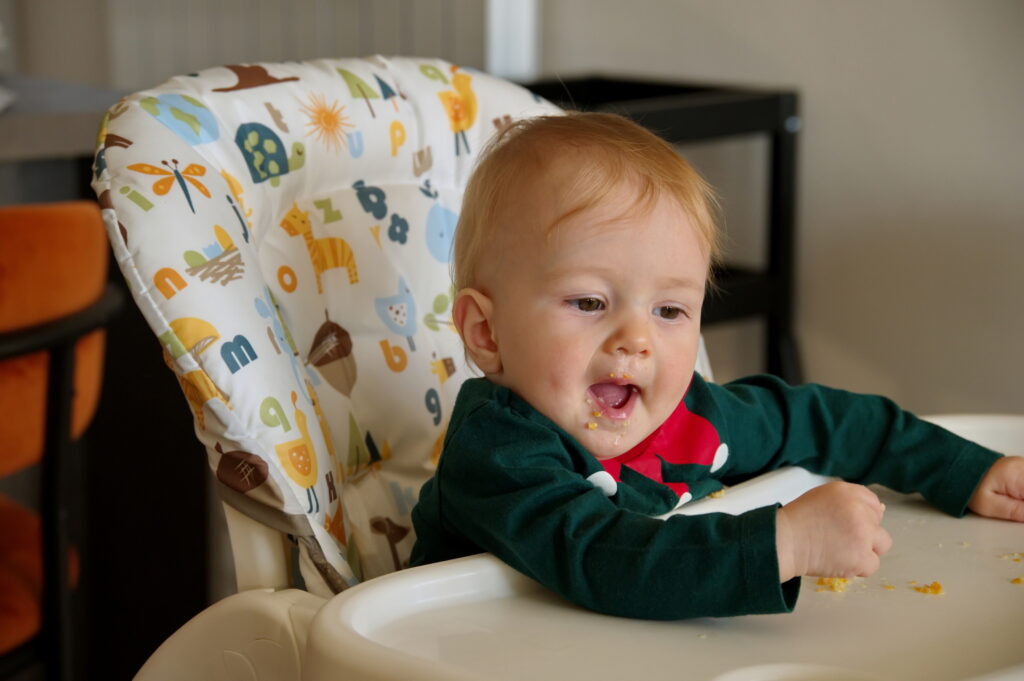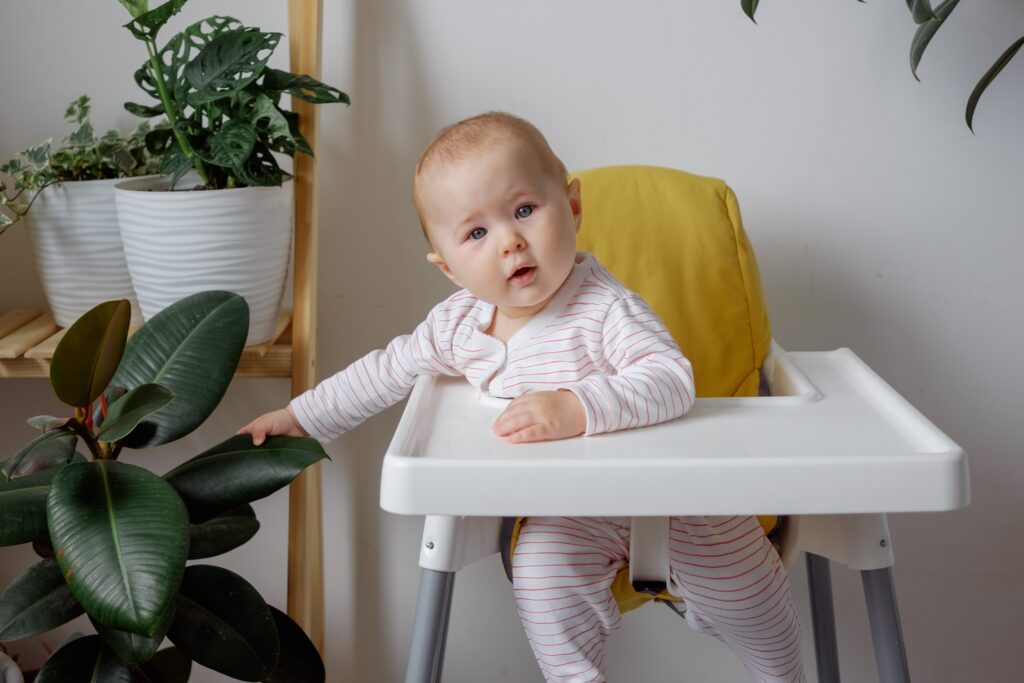A new baby brings excitement, happiness, and a lot of questions into your life. With every growth milestone come fresh experiences and difficulties. One of the most important of these turning points is when your child is ready to use a high chair. This change represents a step toward increased independence, novel eating experiences, and increased family time spent eating together. However, many parents find it difficult to decide when to introduce a high chair. For you and your child, this transition can be easier and more pleasurable if you know the telltale indications of readiness and select the ideal high chair.
Indications Your Child Is Prepared for a High Chair
Although a baby’s development happens at its own rate, there are certain telltale signals that your child may be prepared to use a high chair:
Control of the Head and Neck
The most important sign is that your baby can manage his or her head and neck. This usually occurs between the ages of 4 and 6 months. Your infant should be able to raise their head steadily on their own without assistance. Head and neck control is necessary for your baby’s safety and comfort in the high chair since it guarantees that they can sit up straight without sagging. It’s recommended to hold off on introducing the high chair for a little while longer if your baby still requires assistance to hold their head up.
Leaning back with little assistance
Your infant ought to be able to sit up without any help. They should be able to sit up straight with assistance, even though they might not be able to do so entirely. This typically occurs at the same time that stronger core muscles and improved balance emerge. To find out, try sitting your baby down on your lap or on a cushioned surface and watching how long they can stay in that position. They may be prepared for the high chair if they can remain upright for a few minutes with little to no wobbling.
A Taste for Food
Your baby’s interest in solid foods is another clue. It may be time to get a high chair if they are reaching for your food, observing you eat, or imitating your chewing motions. Their curiosity about their environment and their interactions with family members at mealtimes naturally lead to their interest in food. Mealtimes become more inclusive and interesting for babies who are eager to try what you’re eating and are often ready to join you at the table in their high chair.
The Tongue Thrust Reflex Is Lost
Solid food is automatically pushed out of babies’ mouths by their tongues as a natural response. This reflex normally goes away by the time the baby is 4 to 6 months old, which means they’re ready to start attempting solid foods and use a high chair. By providing a tiny bit of pureed food on a spoon, you can determine whether or not this reflex has been lost. Your baby is probably ready to start eating solids in a high chair if they can swallow the food without sticking their tongue out.

Selecting the Suitable High Chair
The next step is to choose the best high chair if you’ve decided your baby is ready for one. Here are some things to think about:
Security
Make sure the high chair has a sturdy base and a tight-fitting harness. Seek out chairs that feature shoulder straps as part of a five-point harness to ensure your infant is kept safely in place. Prioritizing safety above all else means that you should research any recalls or safety alerts related to the high chair model you are thinking about. Check the chair for any small pieces or sharp edges that could be a choking hazard as well.
Coziness
With a softly padded seat and a footrest to support your baby’s feet, the high chair should be cozy. Certain high chairs have features that may be adjusted to grow with your child. Everyone will enjoy mealtimes more if your infant is able to sit in the high chair for extended amounts of time thanks to a comfy seat. Since spills and messes are unavoidable, think about the chair’s material and how easily cleanable it is.
Cleaning Ease
Infants are renowned for being messy eaters. Select a high chair with easily cleaned surfaces and washable, detachable seat covers. Smooth surfaces and few cracks are great for high chairs because they keep food from sticking in difficult-to-clean areas. For added convenience, look for high chairs with trays that are dishwasher safe.
Flexibility
As your baby grows, a high chair with height and reclining options can be more adaptable and comfortable for them. Long-term value can be obtained from high chairs that can be transformed into toddler or booster seats. The high chair’s adjustable features guarantee that it can adapt to your baby’s changing needs and assist in maintaining an ergonomic seating position, which lowers the possibility of pain or harm.
Mobility
Choose a foldable or lightweight high chair if you intend to transport it or relocate it from room to room. Additionally fantastic for compact living areas or houses with little storage are portable high chairs. For added convenience, look for high chairs with wheels or carrying handles. Make sure the folding mechanism is safe and simple to operate to avoid unintentional collapses or problems when setting up.

Introducing the High Chair to Your Infant
Patience is essential while acclimating your infant to the high chair. The following advice can help to ease the transition:
Get Going Slowly
Even before introducing solid foods, start by putting your baby in the high chair for brief periods of time. Give them time to adjust to their new surroundings. The high chair can be used for playtime or as a secure area where your infant can watch family activities at first. This eases their apprehension about being in a strange environment and helps them link the high chair with pleasant memories.
Establish a Schedule
Set up a consistent mealtime schedule with the high chair. This helps your child learn that eating and family time are associated with the high chair. Try to utilize the high chair at the same times every day because consistency is important. Your infant will eventually learn to anticipate mealtimes in the high chair, which will ease and regularize the transition.
Make Use of Encouragement
When your baby sits in the high chair, give them encouragement and praise. Provide toys or tiny snacks to make it a fun experience. Encouragement increases your baby’s self-assurance and comfort level in the high chair. In addition, you can play with them and converse with them in a happy manner, which will make the high chair an enjoyable place to be.
Remain Near
When your baby is in a high chair, stay close by to make sure they’re safe and to provide them comfort. Your presence eases anxiety and lessens the chance of mishaps. Make the most of this time to talk to your child, spend quality time with them, and join them at mealtimes. Maintaining a close proximity also enables you to react promptly to any indications of unease or anxiety.

Advice on Using a High Chair Safely
Even though high chairs are meant to be safe, it’s still important to heed these extra safety advices:
Wear the harness at all times
Every time your child uses the high chair, even for a brief duration, secure them with the harness system. By keeping your infant from sliding or climbing out of the chair, the harness lowers the possibility of accidents and falls. Make sure your infant can move freely in the harness—it should fit pleasantly yet snugly.
Always exercise supervision
Never leave a baby in a high chair alone. If babies are left alone, they might easily find themselves in hazardous situations. Throughout your baby’s time in the high chair, keep a watchful eye on them and remain within arm’s reach. Take your infant out of the chair if you need to step away, or have another adult watch them.
Verify Stability
Make sure the high chair is positioned on a level, sturdy surface, and routinely inspect it for wear or damage. Serious safety dangers can arise from a high chair that is unstable or broken. Check the chair’s frame, legs, and locking mechanisms on a regular basis to make sure everything is sturdy and functional.
Keep High Chairs Away from Dangers
Remain clear of countertops, tables, and other furniture that your child can bump into and knock over the high chair. Additionally, keep the high chair away from outlets your infant could access, hot surfaces, and sharp objects. Place the high chair in a clear, safe space where your child may eat without running any risks.

The moment your child is ready to use a high chair marks a turning point in both your parenting experience and your child’s increasing independence. It is important that you exercise patience and attention as you make this change. Savor the unique moments when you watch your child learn new things at the dinner table and mark each milestone. You may establish a positive and stimulating dining setting that encourages healthy eating habits and happy family interactions by putting safety, comfort, and gradual introduction first.


